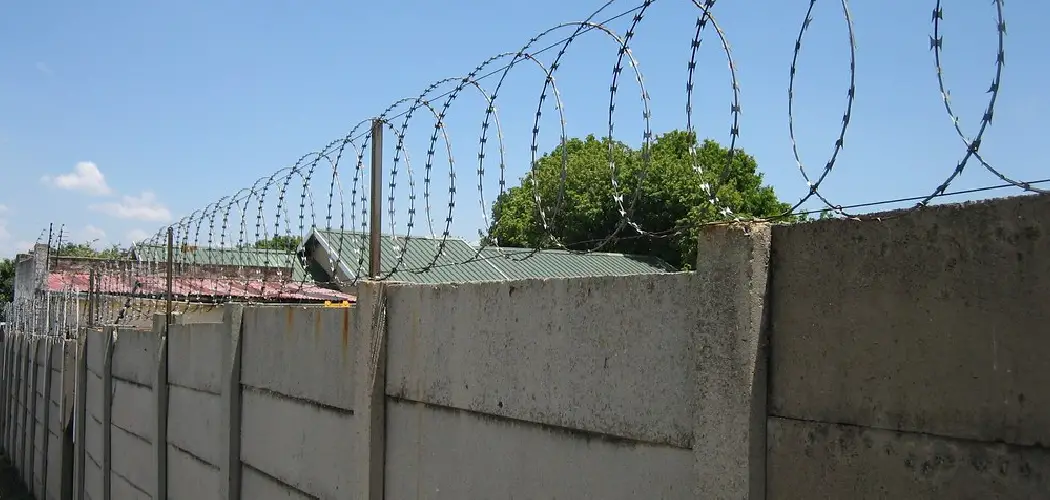Increasing the height of a fence can be a practical solution for various reasons, such as enhancing privacy, boosting security, or simply altering the visual impact of your outdoor space. Whether you’re seeking to shield your property from prying eyes, keep pets contained, or comply with local regulations, learning how to make a fence taller provides a valuable DIY opportunity.

In this article, we will explore effective methods and creative strategies to elevate the height of your existing fence. From plant-based solutions to fence toppers and lattice extensions, these techniques offer versatile and aesthetically pleasing ways to achieve the desired height, ensuring that your fence not only serves its functional purpose but also becomes a stylish and integral part of your property’s overall design.
Need for Taller Fences
The need for taller fences in residential areas is often driven by increasing demands for privacy and security. As homes are built closer together and the distinction between public and private spaces blurs, homeowners find themselves seeking ways to create a sense of seclusion and sanctuary.
Additionally, taller fences can deter potential intruders and provide a safe enclosure for children and pets, minimizing the risk of them wandering off. Environmental factors such as wind and noise pollution may also motivate homeowners to extend the height of their fences, using them as barriers to create a more peaceful and comfortable outdoor living space.
Benefits of Extending Fence Height
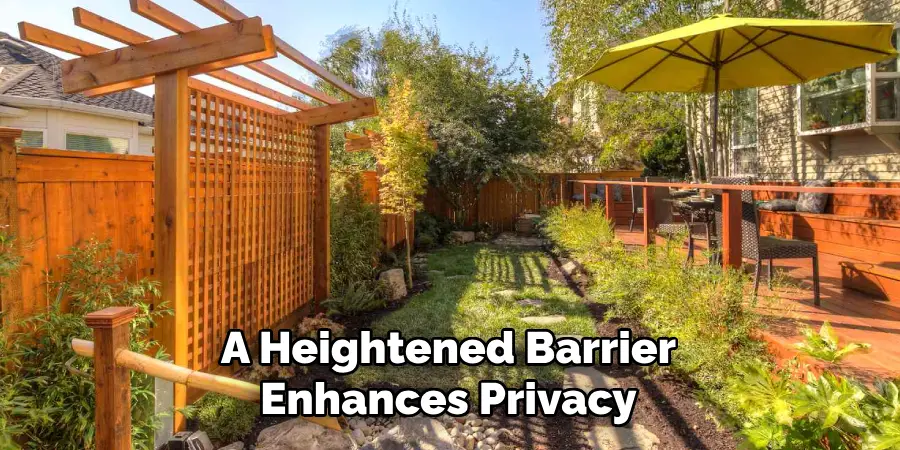
Extending the height of your fence can result in numerous advantageous outcomes. A heightened barrier enhances privacy by obstructing the line of sight from outside your property, allowing you and your family to enjoy your outdoor space without concern for outside observation.
It also increases security by making it more challenging for uninvited guests to access your property. In terms of aesthetics, a taller fence can improve the proportions of your outdoor area, making it feel more enclosed and intimate, which can be particularly appealing in urban environments.
Additionally, a higher fence can serve as a sound barrier to street noise, creating a quieter, more serene backyard oasis. For those with growing plants or vines, the extended surface can also act as a support structure, contributing to a greener and more vibrant garden space.
Understanding Fence Height Regulations
Before attempting to make your fence taller, it’s critical to understand local regulations and obtain the necessary permits. Fence height regulations can vary widely depending on your location, with stipulations often influenced by zoning laws, homeowners association (HOA) rules, and community standards.
These regulations are put in place to ensure safety, preserve sightlines, and maintain a consistent appearance within the neighborhood. It’s advisable to consult with your local building authority or HOA to confirm the maximum allowable fence height, as non-compliance can lead to penalties or the need to modify or remove your enhancements.
Additionally, if you share a boundary line with neighbors, it is a best practice to inform them of your plans to increase your fence’s height as a courtesy and to prevent potential disputes.
Reviewing Local Regulations and Permits
Before embarking on the process of making your fence taller, it is imperative to thoroughly review and comply with local regulations and permitting requirements. Start by contacting your local building department to obtain up-to-date information on the fence height regulations that apply to your property.
This step is crucial as it informs the scope of your project and helps prevent legal issues. In many areas, a permit may be required if the new fence height exceeds a certain limit. This could involve submitting detailed plans and ensuring that your project does not obstruct visibility for drivers or interfere with local utilities.
Reach out to your homeowners’ association as well, if applicable, as they often have additional guidelines on fence aesthetics and heights, which need to be respected to maintain community harmony. By taking these legal prerequisites into account, you ensure that your fence enhancement project progresses smoothly and lawfully.
Choosing the Right Materials
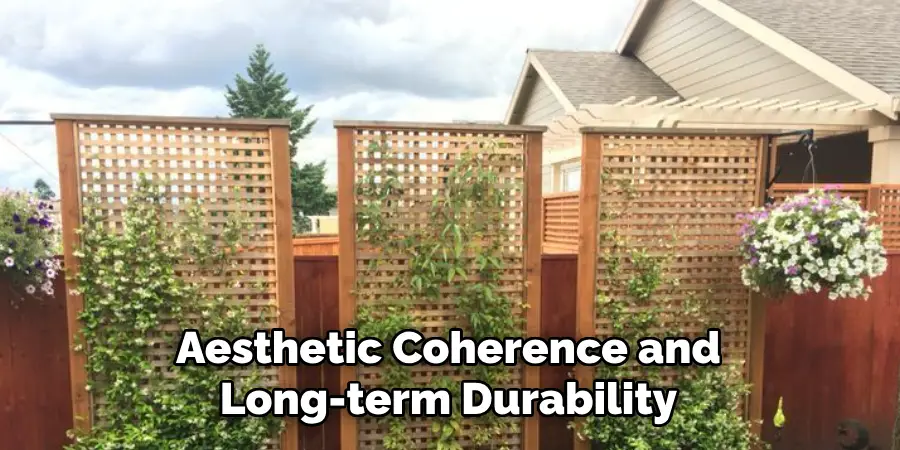
Selecting the right materials for extending your fence is crucial for both aesthetic coherence and long-term durability. The materials should not only match the existing fence in terms of style and color but also withstand outdoor conditions including UV exposure, rain, wind, and changes in temperature.
Common materials for fence extensions include wood, vinyl, composite, and metal. Each has its own set of benefits; wood offers a classic appearance and ease of customization, while vinyl provides low maintenance and resistance to rot and insects.
Composite materials offer a balance of durability and a wood-like appearance, and metals such as aluminum are valued for their strength and rust resistance. When choosing materials, also consider the weight they will add to your existing fence structure to ensure that it can support the additional load without compromising stability.
Extending Existing Fence Panels
To effectively extend existing fence panels, you will need to approach the project with both precision and creativity. Begin by properly assessing your current fence panels to determine their condition and stability.
If the panels are sturdy, you can proceed by adding extension posts or brackets that are designed to increase the height of the fence. These can be attached to the existing posts using screws or bolts. Once the extensions are in place, additional fence material that matches the original can be used to complete the structure. Another popular method is to add a lattice or trellis to the top of the existing panels.
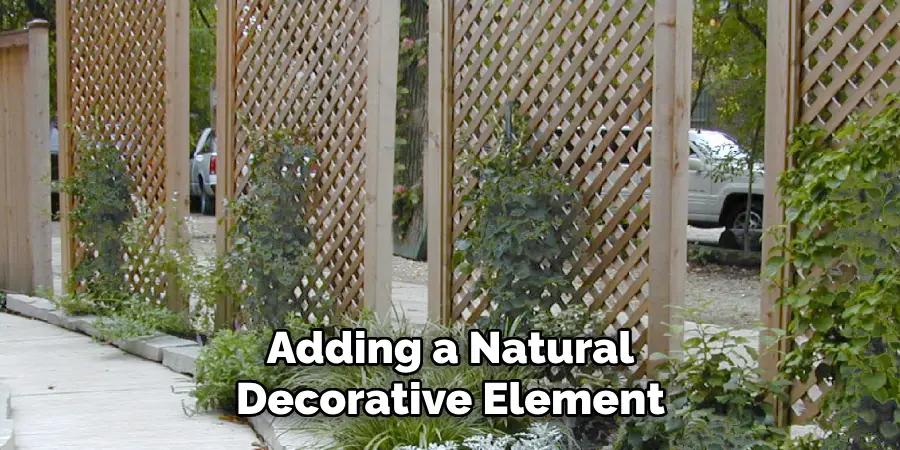
This not only adds height but also provides a support structure for climbing plants, adding a natural decorative element to the fence. Whichever method you choose, it should seamlessly integrate with the existing fence structure to create a cohesive and attractive appearance. Remember to measure twice and cut once, ensuring accuracy and wastage reduction during the installation process.
Researching Local Building Codes and Zoning Regulations
Before making any modifications to your fence, it is essential to diligently research your local building codes and zoning regulations. These rules are typically enforced by your municipal or county government and can dictate everything from the maximum height of structures to the materials that can be used.
To begin your research, visit your local government’s website or contact the building and planning department directly. They can provide specifics on the requirements and restrictions for fence modifications within your jurisdiction.
Also, some areas may have historical preservation or special zoning rules that add another layer of regulation. It’s important to gather this information upfront to avoid potential fines or the need to undo any unauthorized modifications done to your fence.
10 Methods How to Make a Fence Taller
1. Fence Topper Extensions:
One of the most straightforward methods involves adding fence topper extensions. These are pre-made panels or lattice designs that attach to the top of your existing fence. Available in various materials and styles, they not only increase height but also introduce a decorative element to the fence.
Adding fence topper extensions is an excellent option for homeowners who want to maintain the existing structure of their fence but still want some added height. These extensions can be easily attached with screws or nails and are usually made from durable materials such as vinyl, wood, or metal.
2. Bamboo or Reed Screens:
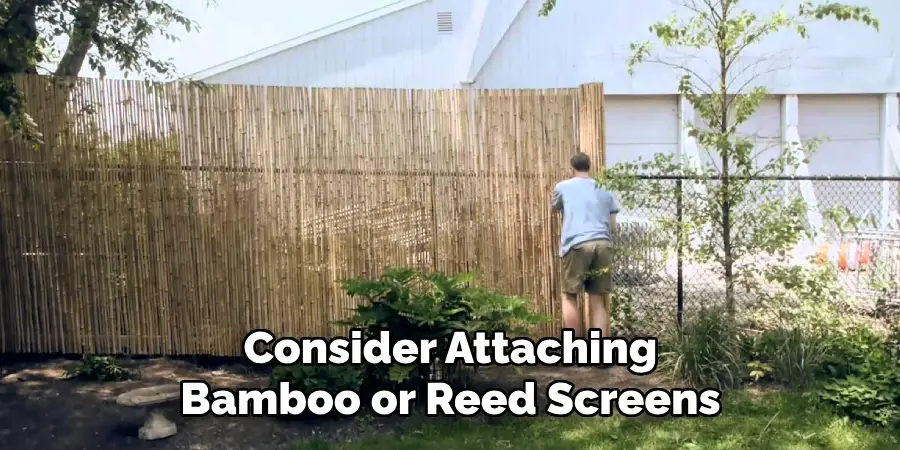
For a natural and visually appealing solution, consider attaching bamboo or reed screens to the existing fence. These materials are lightweight, easy to install, and offer an organic aesthetic while providing additional height and privacy. Bamboo and reed screens are also versatile, allowing for various designs and patterns to be created.
Additionally, they can provide shade and filter sunlight, making them a practical choice for both privacy and functionality.
To install bamboo or reed screens, simply attach the panels with zip ties or staples to the existing fence. Make sure to overlap the panels slightly for full coverage. If desired, you can also add additional support by attaching wooden or metal stakes to the panels and inserting them into the ground. This will provide extra stability in case of wind or extreme weather conditions.
3. Planting Tall Shrubs or Trees:
Integrate greenery into your fence heightening strategy by planting tall shrubs or trees along the fence line. This living fence not only adds height but also brings a lush, natural feel to the space. Choose evergreen varieties for year-round coverage.
Not only do tall plants provide added height to your fence, they also offer a variety of other benefits. First and foremost, planting shrubs or trees along your fence line creates a natural barrier between you and your neighbors. This can help to increase privacy and reduce noise pollution. Tall plants also act as a windbreak, helping to protect your home from strong gusts.
4. Install Trellis Panels:
Trellis panels provide a versatile and decorative option for extending fence height. Mount these panels onto the existing fence structure, and encourage climbing plants or vines to grow on them. This combination of trellis and plants offers both privacy and a touch of greenery.
Trellis panels are a popular choice for homeowners looking to add privacy and greenery to their outdoor space. They are versatile, decorative, and relatively easy to install. In this section, we will discuss the steps involved in installing trellis panels onto an existing fence structure.
5. Create a Raised Bed:
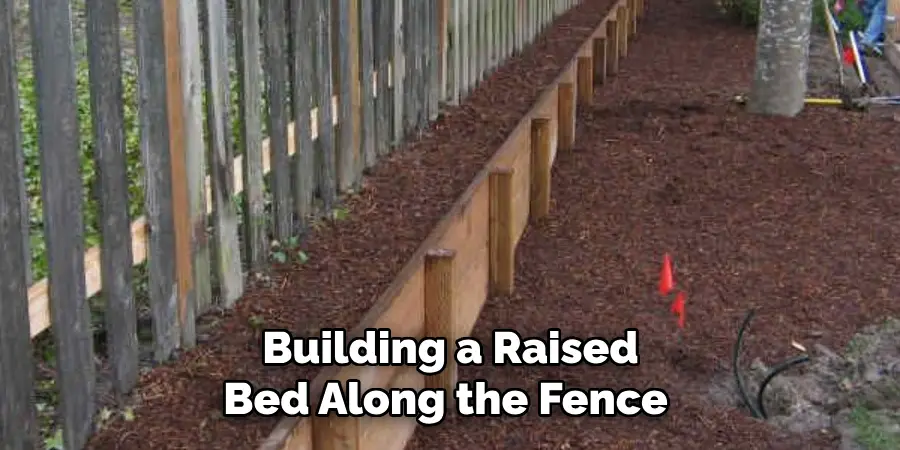
Building a raised bed along the fence allows for the incorporation of taller plants or flowers. This not only adds height to the fence but also creates an attractive border filled with vibrant vegetation, offering a harmonious blend of aesthetics and functionality. Plus, raised beds are excellent for drainage and soil management, providing a fertile environment for healthy plant growth.
Some popular options for plants in raised beds include climbing vines such as jasmine or clematis, which can be trained to grow up the fence, creating a striking vertical display. Shrubs like lavender or hydrangeas also work well in raised beds and will add color and fragrance to the area. You can even mix and match different plants to create a diverse garden bed that will thrive against your fence.
6. Use Potted Plants or Planters:
Opt for portable solutions by placing potted plants or tall planters along the fence. This allows you to control the height and easily change the arrangement as needed. Choose plants with vertical growth patterns for optimal effectiveness. For added convenience, you can use self-watering planters or create a drip irrigation system to ensure your plants always receive the proper amount of water.
Potted plants and planters are not only practical for fencing solutions but also add a decorative touch to your outdoor space. You can choose from different types of pots and planters depending on your personal style and the aesthetic of your backyard. From classic terracotta pots to modern geometric planters, the options are endless.
In addition to adding greenery and visual interest, potted plants and planters can also serve as a buffer for noise reduction. The added layer of foliage can help absorb sound waves and reduce any unwanted noise from reaching your outdoor living space.
7. Install Vinyl Lattice Panels:
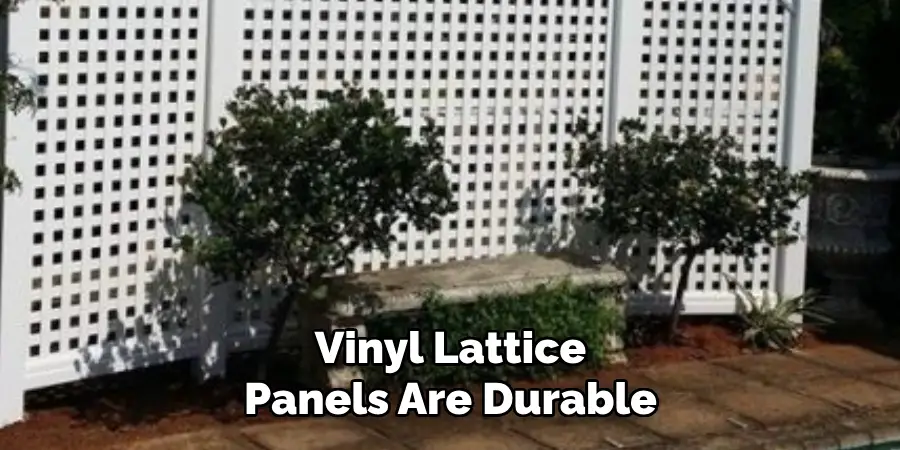
Vinyl lattice panels are durable, weather-resistant, and can be easily installed on top of an existing fence. They provide an elegant and modern look while offering an effective solution for height extension. Choose lattice designs that complement your overall outdoor design. Make sure to measure the dimensions of your fence accurately before purchasing the panels.
8. Hang Outdoor Artwork or Decor:
Combine function and style by hanging outdoor artwork or decor items on your fence. Decorative panels or strategically placed sculptures can add height while turning the fence into a visually appealing focal point.
You can also hang colorful wind chimes or decorative mobiles to add movement and sound to your outdoor space. Don’t be afraid to get creative and use items that reflect your personal style.
9. Utilize Synthetic Hedge Panels:
For an instant privacy boost, consider synthetic hedge panels. These panels mimic the look of natural hedges, providing an attractive and low-maintenance solution for increasing fence height and concealing the space behind. Synthetic hedges are typically made from UV-resistant materials, ensuring that they will maintain their attractive appearance over time. Additionally, these panels come in a variety of styles and colors, allowing you to choose the perfect match for your existing fence.
Synthetic hedge panels are also a great option for adding privacy to balconies or patios. They can be easily installed on existing railings or walls, instantly creating a secluded and intimate space. Plus, unlike natural hedges, synthetic hedge panels do not require regular pruning or maintenance.
10. Combine Multiple Methods:
Tailor your fence heightening approach by combining multiple methods. For example, use a fence topper along with planters or lattice panels to create a layered and visually interesting fence design. Experiment with different combinations to achieve the desired height and aesthetic.
You can also incorporate multiple methods for added functionality. For instance, a fence topper along with trellis panels can provide privacy, shade, and support for climbing plants all in one. Or combining fence extensions with planters can not only add height but also create a green barrier.

Another benefit of combining methods is cost-effectiveness. Instead of investing in separate solutions for different purposes, you can save money by using one method to serve multiple functions.
Planting Tall Shrubs or Trees
When planting tall shrubs or trees, it is crucial to consider their mature size to ensure they have enough space to grow both above and below ground. Proper spacing prevents overcrowding and promotes healthier plants by improving air circulation and sunlight exposure.
Additionally, when selecting a site, be mindful of underground utilities and future shading of your home or garden to optimize energy savings and plant health. Consult a local gardening expert or refer to plant tags for proper spacing and planting instructions.
Incorporating tall shrubs or trees along your fence can add height, texture, and privacy. Some popular options include arborvitae, holly bushes, and flowering dogwoods. Choose plants that thrive in your climate and that complement the style of your outdoor space.
By utilizing a combination of methods and incorporating tall plants, you can easily increase the height of your fence while enhancing the overall aesthetic of your outdoor living space. Consider the options discussed above and tailor them to fit your specific needs and preferences for an effective and visually appealing solution.
Conclusion
In conclusion, increasing the height of a fence can significantly enhance privacy, security, and aesthetics in a property. By adhering to local regulations, obtaining necessary permits, and exploring various methods such as fence extensions, post extensions, additional panels, and natural barriers like tall shrubs or trees, homeowners can effectively elevate the height of their fence to meet their needs.
It’s essential to maintain visual harmony with the surrounding landscape and neighboring properties while ensuring compliance with local regulations.
Whether seeking to create a more secluded outdoor space, enhance security measures, or improve the overall appearance of the property, making a fence taller requires careful planning and consideration of the available options. Thanks for reading, and we hope this has given you some inspiration on how to make a fence taller!
About
Outdoor Fixes is a distinguished figure in the world of Diy design, with a decade of expertise creating innovative and sustainable Diy solutions.
His professional focus lies in merging traditional craftsmanship with modern manufacturing techniques,
fostering designs that are both practical and environmentally conscious. As the author of diy,
outdoorfixes delves into the art and science of outdoorfixes-making, inspiring artisans and industry professionals alike.
Education RMIT University
(Melbourne, Australia) Associate Degree in Design (Outdoor Fixes) Focus on sustainable design, industry-driven projects,
and practical craftsmanship. Gained hands-on experience with traditional and digital manufacturing tools, such as CAD and CNC software.
Nottingham Trent University
(United Kingdom) Bachelor’s in outdoorfixes.com and Product Design (Honors) Specialized in product design with a focus on blending creativity with production
techniques. Participated in industry projects, working with companies like John Lewis and Vitsoe to gain real-world insights.
Publications and Impact
In diy, Outdoor Fixes his insights on indoor design processes, materials, and strategies for efficient production.
His writing bridges the gap between artisan knowledge and modern industry needs, making it a must-read for both budding designers and seasoned professionals.

